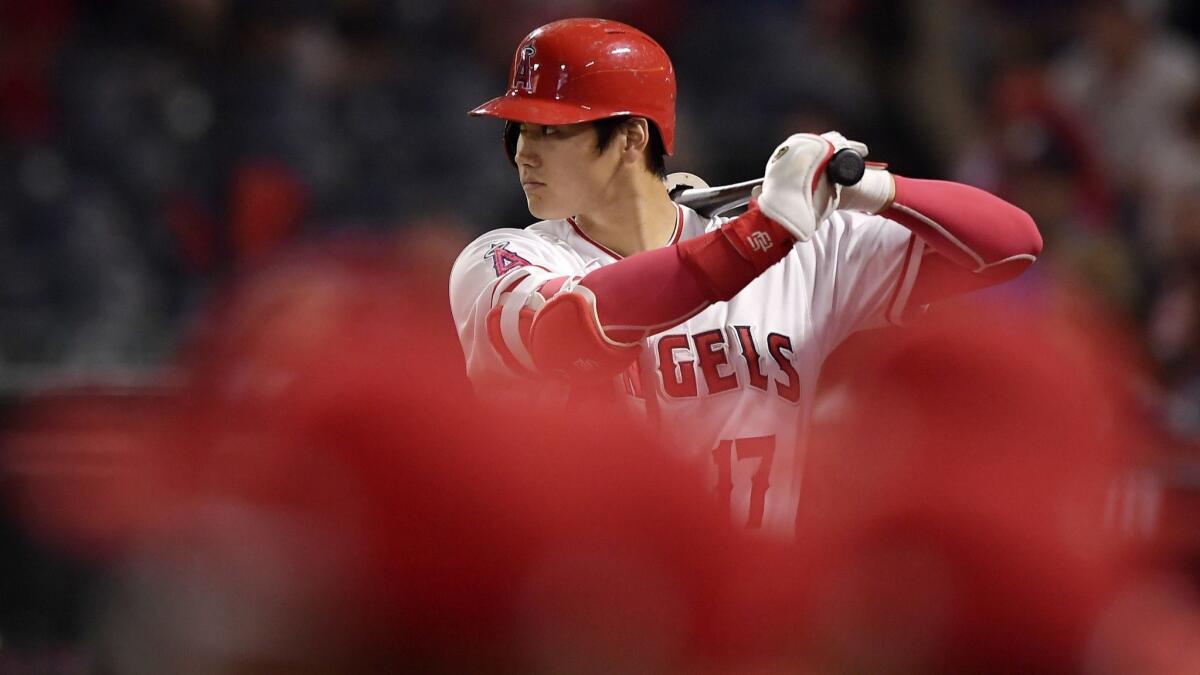Column: Focus on hitting ought to boost Shohei Ohtani’s numbers

- Share via
Shohei Ohtani would reject it and the Angels would never do it, not to mention the fans, who would absolutely deplore it.
Still, the idea is worth contemplating, which is why the scout on the phone raised the possibility of Ohtani eventually becoming a full-time hitter.
“This season could move him in that direction,” said the scout, who works for a National League team.
Ohtani isn’t expected to pitch again until 2020, as he is only six months removed from reconstructive elbow surgery.
If there is disappointment over the temporary disappearance of the only two-way act in the major leagues, however, there is also equal anticipation over what the Japanese power hitter could do at the plate with his undivided attention.
“He put up unbelievable numbers last year,” Angels outfielder Mike Trout said. “I’m excited for this year.”
As a major league rookie, the left-handed-hitting Ohtani batted .285 with 22 home runs and 61 runs batted in. He made 367 plate appearances in 104 games as a hitter, including 82 starts.
Although Ohtani is expected to be on the injured list through the first month of the season, he is expected to play in more games and make more plate appearances.
“I think you’ll see his offensive performance elevate even further,” former Dodgers general manager Dan Evans said.
In his former role as a scout with the Toronto Blue Jays, Evans monitored Ohtani since he was an 18-year-old rookie with the Hokkaido Nippon-Ham Fighters. Evans was familiar enough with Ohtani to know that his underwhelming form in spring training last year wasn’t a reason for concern.
“He’ll be fine,” Evans said at the time. “He’s like this every year.”
As someone who has tracked Ohtani over each of his seven years as a professional, Evans is certain he is still a developing player. Ohtani is only 24.
“Take a look at his age and his experience level,” Evans said. “There’s a lot more in there. He’s a potential Hall of Fame talent, for me.”
Evans pointed to how Ohtani evolved over his six seasons in Nippon Professional Baseball, particularly leading up to the 2017 season. Previously a pull hitter, Ohtani started sending balls to the opposite field with greater frequency. He batted a career-high .332 that season.
Before he injured his elbow, Ohtani was typically available to hit four days a week. He didn’t step in the batter’s box on days he pitched, as well as the days immediately before and after. He made one start a week on the mound.
As disruptive as that schedule appeared from the outside, Ohtani became accustomed to it.
“I think playing in every game will be tough, as will having to continue to play during a slump,” he said in Japanese.
Whenever Ohtani was previously out of sorts at the plate, he was able to mentally reset while making a start on the mound.
By taking more at-bats, Ohtani will risk exposing his weaknesses to opposing pitchers. But Evans believes Ohtani will remain a step ahead of the pitchers in the game of cat and mouse.
“He’s a very intuitive and instinctive player with a feel for in-game changes,” Evans said.
Ohtani is also hopeful that will be the case.
“More than confidence, it’s feeling acclimated, knowing the opposing pitchers, knowing how they are going to attack me,” Ohtani said.. “Knowing that rather than not knowing, I think it’s a plus for me.”
Trout mentioned how easily Ohtani made changes to his timing mechanism from spring training to the regular season.
Sign up for our daily sports newsletter »
“The main thing I see about him is the adjustments he makes, going from a leg kick in spring and then, first day, opening day, goes to a toe tap and he’s hitting balls like 500 feet,” Trout said. “He’s unbelievable.”
Evans didn’t want to predict what Ohtani’s offensive numbers would look like at the end of the season, but the aforementioned NL scout said Ohtani could finish with 30 home runs and a .300 average if he gets 400 or more at-bats.
“He hit 20 (home runs) in half a season,” said the scout, who spoke under the condition of anonymity because his team doesn’t allow him to publicly comment on players on other teams.
The same scout said if Ohtani abandoned pitching and became an everyday player, he could hit 50 home runs.
Even if he never does, the scout predicted Ohtani would lower his strikeout rate, which was 27.8% last year.
“He’s a big guy, he’s always going to have a longer swing,” he said. “But there’s no reason he can’t be an above-average contact guy. He can be a 15-17% strikeout guy.”
Similar to Evans, this particular scout has tracked Ohtani since he was in Japan. In his view, Ohtani’s mental makeup will be the reason he continues to improve.
“He’s Roy Hobbs,” the scout said. “He wants to be the best there ever was.”
Freeing Ohtani from the burden of pitching could also free him on the basepaths. He had 10 stolen bases last year, nine of which came after he injured his pitching elbow in mid-June.
“The part of his game that people forget is that he can really run,” Evans said. “He’s in the top 10% in baseball. He could easily steal 20 bases or more.”
Both Evans and the anonymous scout said that athleticism could translate to Gold Glove-caliber defense in right field, maybe even center. Ohtani played the outfield at times in Japan.
“I think he’s one of the best five position players if he played the field full-time and one of the best right fielders ever,” the NL scout said.
The scout is a believer in Ohtani’s talent on the mound. Before Ohtani moved to the United States, the scout was certain he would be able to play both ways in the major leagues. And while Ohtani was able to touch 100 mph with his fastball, the scout said, “I just think he’s more special on the field and at the plate.”
But Evans thinks the added experience at the plate will help Ohtani as a pitcher.
“He’ll know more about what hitters go through,” Evans said. “He may have a different approach after having that many plate appearances.”
Evans warned against placing any limitations on what Ohtani could do.
“This guy is a one-of-a-kind,” Evans said.
He already showed that last year. He could demonstrate that again, only in another way.
Follow Dylan Hernandez on Twitter @dylanohernandez
More to Read
Go beyond the scoreboard
Get the latest on L.A.'s teams in the daily Sports Report newsletter.
You may occasionally receive promotional content from the Los Angeles Times.











